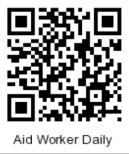Some of you probably cannot figure out why I keep harping on 2D barcodes as a resource for humanitarian aid workers. For those of you who have no idea what 2D barcodes even look like:
They are a way of compiling up to 1/2 page worth of information into a postage stamp sized, mobile phone readable, matrix design like the one you see above. The most ubiquitous type of 2D barcodes are QR Codes. The information within the code is easily accessed with a 2D barcode reader. If you have an Apple iPhone or any one of a number of Nokia phones you can download 2D Sense, Neoreader, iDecode or any one of these readers. There is also a reader made by ScanLife but it reads proprietary codes that are currently involved in a restaurant review roll out in San Francisco. Nokia also has it’s own 2D barcode reader that comes pre-installed on a number of phones or you can download it here.
If you have the requisite hardware and have downloaded the App you are going to use fire it up and snap a pic of the Aid Worker Daily code you see above. If you are using an iPhone the reader will ask you if you would like to visit www.aidworkerdaily.com. You will then (of course) click ‘yes’ and now you can read more of these fascinating posts while you wait in line for a cup of coffee. 2D barcodes can encode a wide array of information, even audio, and are commonly used on Japanese business cards where they provide easy access to a person’s contact information.
How many times have you arrived at UN coordination meeting, met dozens of people, all of whom told you the exact same thing, “This is my most recent business card. The email is still good but I am waiting on my new cards with my local address and new mobile number.”? It has happened to me plenty of times and it is the same mind numbingly slow process that inevitably detracts, albeit slightly, from the mission at hand. It is a waste of time and for which until now there really has not been a suitable solution aside from heading back to the office, emailing your information to the recipients address, and then waiting for a response with his info. Or you sit there for 5 minutes typing in each person’s name until you have covered about half the folks you wanted to meet and the other half have already left.
Now there is a solution and here is how you solve the problem…
When you arrive on location find out your address, phone number and any other relevant contact information. Fire up your laptop and head on over to i-nigma to create you own personal 2D barcode. Select ‘Contact details’ and fill in the blanks. It should look something like this:
You now have your very own code! Right click on the image and save it to your desktop. Print it out on a piece of paper and tape it to the back of your phone. (Ok, I admit the taping part is a bit hokey but I always taped my new number to the back of my phone so I always had easy access to it.) Now, when you go to a coordination meeting simply hold up the back of your phone, let your new friend snap a pic of it, and your contact information should immediately become accessible on his or her phone! No more waiting, typing, etc. You can also attach this image to an email and folks can snap a pic of it straight off of their computer screen.
Nokia has a similar service which you can access here and which looks like this:
There are a host of other generators out there and most of them will allow you top enter text, web addresses, or contact information. For example, you could easily generate code with meeting schedules for different sectors embedded in them and then post them on one sheet near the entrance so that attendees could snap a few pics on the way out and have the entire schedule saved in their phone.
There are many possibilities and I am fairly certain that you will soon see 2D barcodes showing up in a whole of humanitarian applications. Next time I’ll write about how to embed your coordinates, or even a .KMZ file for Google Earth, in a 2D barcode.




{ 2 comments… read them below or add one }